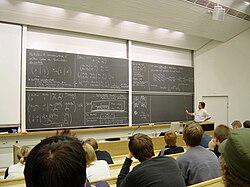Finnish female politicians highlighted by World Bank's 2012 gender report
Sunday, September 29, 2013
Earlier this week the World Bank released the 2012 World Development Report on Gender Equality and Development. The report noted relatively high numbers of women participating in Finnish politics, and credited the Council for Equality between Men and Women in Finland with progress.

Image: Agência Brasil.
Finland bucks the global trend; the report notes globally "the number of women holding parliamentary seats is very low, and progress in the last 15 years has been slow." Female representation in national parliaments has risen from 10% in 1995 to 17% in 2009. By contrast, Finnish female parliamentarians accounted for 38.5% of new members in 1991, rising to 42.5% in 2011. Finland was one of just nine nations whose total female cabinet members stood at more than 40% in 2008. Globally, females accounted for 17% of ministers, representing a rise from just 8% in 1998.
Although not specifically mentioned by the report, since the millennium the positions of President and Prime Minister have both been held by women; Tarja Halonen became the nation's first female President in 2000 and in 2010 Mari Kiviniemi was selected to be the second female Prime Minister. Women gained suffrage in 1906 with little opposition, ahead of the US and UK.

Image: Tungsten.
The cross-party Council for Equality between Men and Women in Finland dates back to the 1970s; the World Bank dismisses its role at that time as "primarily symbolic" with little in the way of staff, funding, or influence. In the 1980s it was handed statutory power for gender equality issues and has gone on to press for reforms in areas including sex work, job training, and quotas on political representation. The report calls the council a "success".
Education, however, showed gender segregation by subject at the tertiary level; Finland was one of several countries singled out as examples of high gender segregation in economically developed countries, compared to lower levels of segregation in less well-developed nations. Finland is one of the four members of the Organisation for Economic Co-operation and Development with the highest segregation by subject alongside Croatia, Japan, and Lithuania.
Finland has very high levels of education enrollment for both boys and girls, at almost 100% at primary level. Females are ahead of men in tertiary education enrollment, with 46% of men in the relevant age group enrolling in 1991 and 52% of women. By 2009 these numbers stood at 82% and 101% respectively.
Boys and girls were neck and neck with high scores in their 2009 Programme for International Student Assessment maths tests, both averaging around 540. Literacy also produced very high scores but with a gender gap; boys averaged around 510 while girls averaged around 560.
Internet access in Finland is high with men slightly ahead; for men and women alike access stands at around 85%. Finns have a legal right to a 1Mbps broadband connection and authorities plan to have 100Mbps connections for every citizen by 2015. The proportion of women teleworking at least 25% of the time has risen from around 7% in 2000–1 to 9% in 2005; the male figure was at 9% in 2005 and is now 15–20%. Rapid teleworking growth is a global trend but the report notes the female figures generally grew faster.
Marketplace activities also show gender disparity in Finland. Of activities performed by men and women, the female share stands at 41%, versus 63% for domestic activities such as housework. From 2006–9 services accounted for 87% of female and 56% of male employment. 10% of women and 37% of men were employed in industry and agriculture was only a minor employer, with 6% of male employment and 3% of female employment.
Life expectancy for Finnish men has risen from 71 years in 1990 to 77 years in 2009; in the same period, women's life expectancy increased from 79 years to 83 years. The population stands at 5 million, representing a 0.4% annual growth rate from 2000 to 2010.
Sources
- Press release. "Many Societies Gradually Moving to Dismantle Gender Discrimination, Yet More Can Be Done, Says World Bank Group President Jim Yong Kim" — World Bank, September 24, 2013
- "2012 World Development Report on Gender Equality and Development" — World Bank, September 24, 2013
- "Finland makes broadband a 'legal right'" — BBC News Online, July 1, 2010
- Matilda Battersby. "The 16 women taking over the world" — The Independent, June 24, 2010
- "Finland picks new prime minister Mari Kiviniemi" — BBC News Online, June 22, 2010




